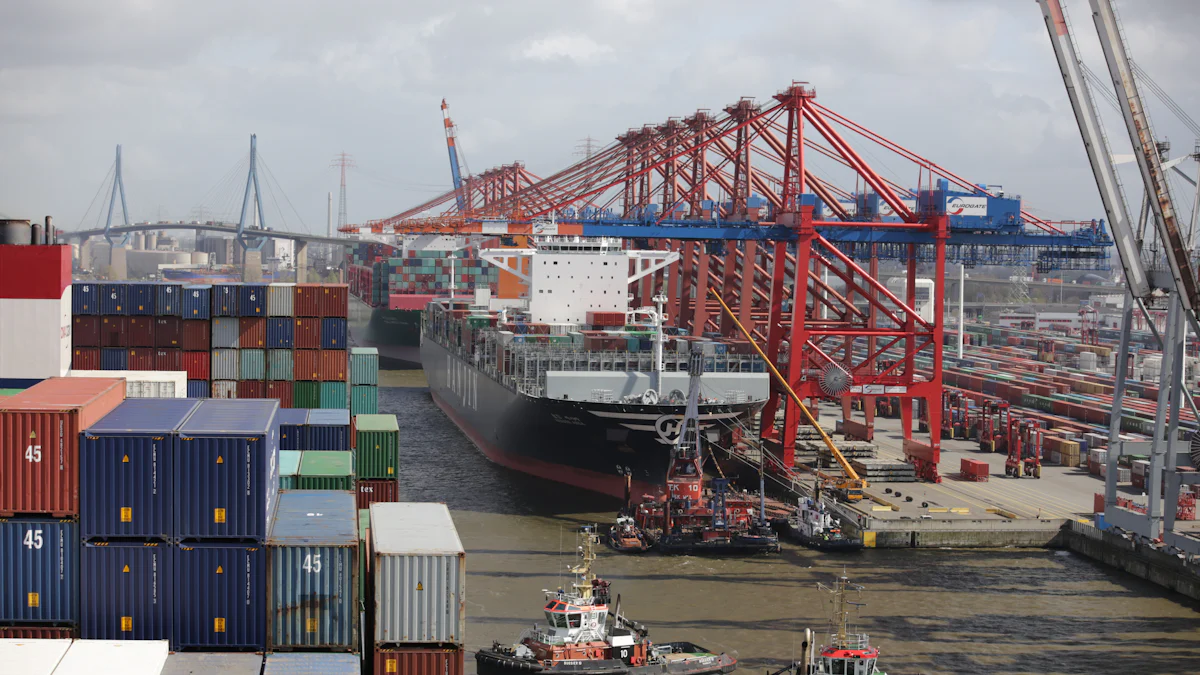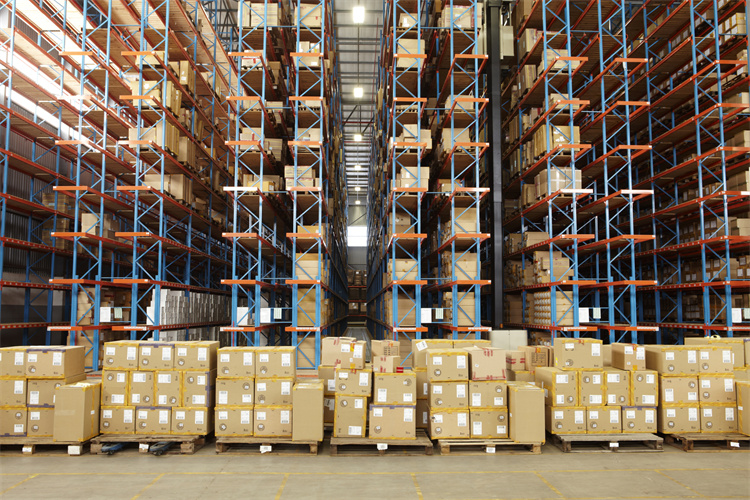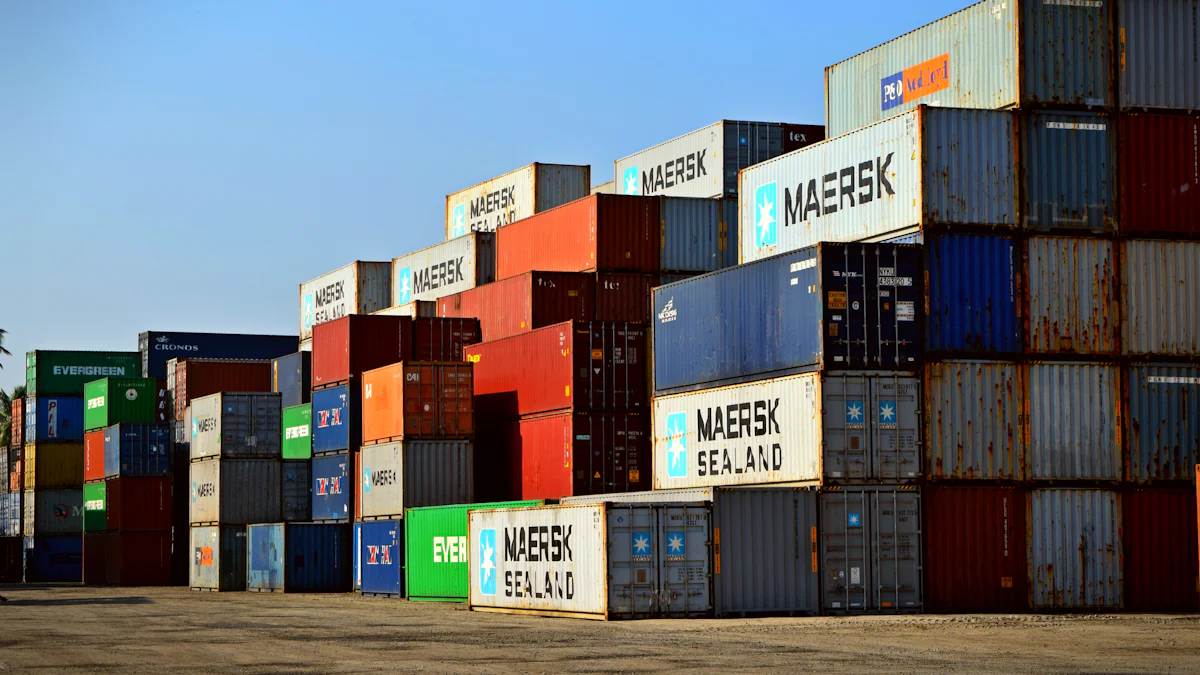Ultimate Guide to Sea Freight: International Shipping Process, Costs, and Money-Saving Tips

Ocean freight plays a pivotal role in global trade. It enables the movement of goods across continents, allowing businesses to access international markets and expand their reach. This method of shipping not only supports the supply chain but also offers a lower carbon footprint compared to air freight. Understanding the costs and processes involved in ocean freight is crucial for businesses. It helps you make informed decisions, optimize logistics, and ultimately save money. As shipping firms adopt cleaner fuels and energy-efficient technologies, the importance of grasping these elements becomes even more significant.
Key Takeaways
Ocean freight is a cost-effective shipping method, especially for large shipments, making it ideal for businesses looking to save on logistics costs.
Understanding Incoterms is crucial for determining who pays for shipping costs, helping to avoid disputes and manage logistics effectively.
Familiarize yourself with common ocean freight fees, such as Terminal Handling Charges and Documentation Fees, to better manage your shipping budget.
Consolidating shipments can significantly reduce costs by maximizing container utilization and taking advantage of economies of scale.
Partnering with freight forwarders can help you negotiate better rates and streamline the shipping process, reducing the risk of costly errors.
Stay informed about market trends to adjust your shipping strategies, as shipping during off-peak seasons can lead to lower rates.
Consider alternatives like JUSDA's China-Europe Express Rail for faster transit times and cost-effective solutions while supporting sustainable practices.
Understanding Ocean Freight

What is Ocean Freight?
Ocean freight refers to the transportation of goods across the sea using large ships. This method is the backbone of international trade, handling over 90% of the world's goods. You can think of it as a massive conveyor belt that connects continents, allowing businesses to move products efficiently and cost-effectively. Ocean freight typically involves the use of standard containers, such as 20-foot or 40-foot units, which can carry a wide range of goods. This flexibility makes it an ideal choice for transporting bulky or large quantities of items.
Importance of Ocean Freight in Global Trade
Ocean freight plays a crucial role in global trade. It offers several advantages that make it indispensable for businesses looking to expand their reach. Here are some key points highlighting its importance:
Cost-Effectiveness: Ocean freight is generally more affordable than air freight, especially for large shipments. This cost advantage allows you to transport goods at a lower price, making it a preferred choice for businesses dealing with high-volume shipments.
Capacity and Flexibility: With the ability to ship larger volumes, ocean freight provides flexibility in terms of goods restrictions. You can transport a diverse range of products, from electronics to raw materials, without worrying about size limitations.
Environmental Impact: Compared to air freight, ocean freight has a lower carbon footprint. This makes it a more environmentally friendly option, aligning with the growing emphasis on sustainable business practices.
Global Connectivity: Ocean freight connects major ports worldwide, facilitating international trade. This connectivity enables you to access new markets and expand your business operations globally.
Who Pays for Ocean Freight?
Understanding who pays for ocean freight is crucial in international shipping. The responsibility often depends on the terms agreed upon between the buyer and the seller. These terms, known as Incoterms, play a pivotal role in determining cost responsibility.
Role of Incoterms in Determining Cost Responsibility
Incoterms, short for International Commercial Terms, are a set of rules that define the responsibilities of sellers and buyers in international transactions. They clarify who pays for and manages various aspects of the shipping process, such as shipment, insurance, documentation, and customs clearance. By specifying these responsibilities, Incoterms help avoid confusion or disputes in sales contracts. Although not mandatory, they become legally binding when included in a signed commercial contract. Therefore, it's essential to clearly specify which set of Incoterms is being used in the sales agreement to facilitate smooth global trade.
Examples of Common Incoterms
FOB (Free on Board)
Under FOB, the seller fulfills their obligation once the goods are loaded onto the ship. You, as the buyer, take responsibility for the costs and risks from that point onward. This term is commonly used in ocean freight, as it clearly delineates the transition of responsibility at the port of shipment.
CIF (Cost, Insurance, and Freight)
CIF requires the seller to cover the costs, insurance, and freight necessary to bring the goods to the port of destination. However, the risk transfers to you, the buyer, once the goods are loaded onto the ship. This term provides a level of security, as the seller arranges and pays for insurance during transit.
EXW (Ex Works)
EXW places the maximum responsibility on you, the buyer. The seller makes the goods available at their premises, and you handle all transportation costs and risks from there. This term is often used when you want full control over the shipping process, including the choice of carrier and route.
Understanding these Incoterms helps you navigate the complexities of international shipping. By knowing who pays for what, you can better plan your logistics and manage costs effectively.
Breakdown of Ocean Freight Fees
Understanding the various fees associated with ocean freight is essential for managing your shipping costs effectively. These fees can vary depending on the shipping route, the type of goods, and the specific services required. Here's a breakdown of the common fees and additional costs you might encounter.
Common Fees and Charges
When shipping goods via ocean freight, you will encounter several standard charges. These fees are necessary for the smooth handling and transportation of your cargo.
Terminal Handling Charges (THC)
Terminal Handling Charges cover the cost of moving your cargo within the port. This includes loading and unloading containers from the ship, as well as any storage or handling required at the terminal. You pay these charges to the port authority or the shipping line, and they are typically included in the overall freight cost.
Documentation Fees
Documentation Fees are charged for the preparation and processing of shipping documents. These documents include the bill of lading, customs declarations, and other necessary paperwork. Accurate documentation ensures compliance with international shipping regulations and facilitates smooth customs clearance.
Bunker Adjustment Factor (BAF)
The Bunker Adjustment Factor accounts for fluctuations in fuel prices. Shipping lines apply this surcharge to offset the cost of fuel used during the voyage. Since fuel prices can vary significantly, the BAF helps stabilize shipping costs by adjusting them according to current market conditions.
Additional Costs to Consider
Beyond the standard fees, you should also be aware of additional costs that may arise during the shipping process. These costs can impact your overall budget and should be factored into your planning.
Customs Duties
Customs Duties are taxes imposed by the government on imported goods. The amount you pay depends on the type of goods, their value, and the country of origin. Understanding the applicable duties for your shipment helps you avoid unexpected expenses and ensures compliance with import regulations.
Port Fees
Port Fees cover various services provided by the port, such as docking, pilotage, and security. These fees can vary depending on the port and the specific services required for your shipment. It's important to account for these costs when calculating your total shipping expenses.
By familiarizing yourself with these fees and charges, you can better manage your ocean freight costs and make informed decisions about your shipping strategy. This knowledge empowers you to optimize your logistics and potentially save money in the long run.
How Ocean Freight Costs are Calculated

Understanding how ocean freight costs are calculated is essential for managing your shipping expenses effectively. By grasping the factors that influence these costs, you can make informed decisions and optimize your logistics operations.
Factors Influencing Costs
Several key factors determine the cost of ocean freight. Recognizing these elements helps you anticipate expenses and plan accordingly.
Distance and Route
The distance between the origin and destination significantly impacts shipping costs. Longer routes generally incur higher costs due to increased fuel consumption and time at sea. Additionally, the chosen route can affect pricing. Some routes may have higher demand or face geopolitical challenges, influencing the overall cost.
Container Type and Size
The type and size of the container you choose also play a crucial role in determining costs. Standard containers, like 20-foot or 40-foot units, are commonly used. However, specialized containers for temperature-sensitive or oversized cargo may incur additional charges. Maximizing your cargo size by booking Full Container Load (FCL) can reduce the cost per unit, but consider potential drawbacks like increased warehousing costs.
Market Conditions
Market conditions, including supply and demand dynamics, can cause fluctuations in shipping rates. During peak seasons, when demand for shipping services rises, costs may increase. Conversely, off-peak periods might offer more competitive rates. Staying informed about market trends allows you to adjust your shipping strategies and potentially save money.
Calculating Total Shipping Costs
To calculate the total shipping costs, you need to consider all the factors mentioned above. Start by identifying the base freight rate, which depends on the distance, route, and container specifications. Then, account for additional fees such as Terminal Handling Charges (THC), Documentation Fees, and Bunker Adjustment Factor (BAF). Don't forget to include customs duties and port fees, which vary based on the destination and type of goods.
By understanding these components, you can estimate your total shipping expenses accurately. This knowledge empowers you to negotiate better rates and optimize your logistics operations, ultimately leading to cost savings.
Money-Saving Tips for Ocean Freight
Reducing ocean freight costs can significantly impact your business's bottom line. By implementing strategic measures, you can optimize your logistics operations and enhance profitability. Here are some practical tips to help you save money on ocean freight.
Use of Freight Forwarders
Freight forwarders play a crucial role in managing shipping logistics. They possess the expertise and resources to negotiate better rates with carriers. By partnering with a reliable freight forwarder, you can benefit from their established relationships and volume discounts. This collaboration allows you to secure competitive pricing and streamline your shipping process. Additionally, freight forwarders handle documentation and customs clearance, reducing the risk of costly errors.
Understanding and Leveraging Market Trends
Staying informed about market trends is essential for optimizing your shipping strategy. By understanding the factors that influence ocean freight costs, such as fuel prices and geopolitical events, you can make informed decisions. For instance, shipping during off-peak seasons often results in lower rates due to decreased demand. Monitoring market conditions enables you to adjust your shipping schedules and capitalize on cost-saving opportunities.
"Skyrocketing global trade has made ocean freight an essential lifeline for many businesses today. But let’s be real – high seas don’t have to mean high shipping costs." - Multiple Experts
Consolidating Shipments
Consolidating shipments is an effective way to reduce shipping costs. By combining multiple smaller shipments into a single larger one, you can take advantage of economies of scale. This approach lowers the cost per unit and maximizes container utilization. Collaborating with other businesses to share container space can further enhance savings. Consolidation not only reduces freight expenses but also minimizes handling and documentation fees.
Implementing these money-saving tips can lead to significant cost reductions in your ocean freight operations. By leveraging the expertise of freight forwarders, staying informed about market trends, and consolidating shipments, you can optimize your logistics strategy and improve your business's profitability.
Negotiating with Carriers
Negotiating with carriers can significantly reduce your ocean freight costs. By developing strong negotiation skills, you can secure better rates and terms for your shipments. Here are some strategies to help you negotiate effectively:
Understand Your Shipping Needs: Before entering negotiations, clearly define your shipping requirements. Know the volume, frequency, and specific needs of your shipments. This information will help you communicate effectively with carriers and demonstrate your value as a customer.
Research Carrier Options: Explore different carriers and their offerings. Compare their rates, services, and reliability. Having multiple options gives you leverage in negotiations and allows you to choose the best fit for your business.
Leverage Long-Term Contracts: If you ship regularly, consider negotiating long-term contracts with carriers. Many carriers offer discounts to businesses that provide consistent volumes. This approach not only reduces costs but also ensures reliable service.
Highlight Your Value: Emphasize the benefits of partnering with your business. Highlight your consistent shipping volumes, potential for future growth, and commitment to a long-term relationship. Demonstrating your value can lead to more favorable terms.
Be Prepared to Walk Away: Don't be afraid to walk away if the terms don't meet your needs. Having alternative options allows you to negotiate from a position of strength. Remember, the goal is to secure the best deal for your business.
"Reducing ocean freight prices requires a comprehensive approach that encompasses strategic planning, negotiation skills, operational optimization, and effective use of technology." - Multiple Experts
By mastering these negotiation strategies, you can lower your ocean freight costs and enhance your logistics operations.
JUSDA's China-Europe Express Rail as an Alternative
JUSDA's China-Europe Express Rail offers a compelling alternative to traditional ocean freight. This innovative service connects China and Europe through a reliable railway network, providing several advantages:
Faster Transit Times: The China-Europe Express Rail delivers goods in 15-20 days, significantly faster than sea freight. This speed makes it ideal for time-sensitive shipments.
Cost-Effective Solution: While rail transport costs more than sea freight, it is still more affordable than air freight. This balance between speed and cost makes it an attractive option for businesses looking to optimize logistics expenses.
Versatile Cargo Handling: The service accommodates a wide range of products, including electronics, clothing, and medical supplies. This versatility allows you to transport diverse goods efficiently.
Reduced Risk of Delays: JUSDA's extensive network and expertise ensure smooth customs operations and resource alignment. This minimizes the risk of goods being stranded, enhancing reliability.
Environmental Benefits: Rail transport has a lower carbon footprint compared to air freight, aligning with sustainable business practices.
By considering JUSDA's China-Europe Express Rail, you can explore a faster and potentially more cost-effective shipping solution. This alternative not only reduces transit times but also supports your sustainability goals.
Conclusion
Recap of Key Points
You have explored the essential aspects of ocean freight, a vital component of global trade. Ocean freight enables businesses to transport goods across continents efficiently and cost-effectively. You learned about the significance of Incoterms in determining who pays for shipping costs and how these terms can impact your logistics strategy. Understanding the breakdown of ocean freight fees, including Terminal Handling Charges and Documentation Fees, equips you to manage your shipping expenses better. You also discovered how factors like distance, container type, and market conditions influence shipping costs. By calculating total shipping expenses accurately, you can optimize your logistics operations.
Encouragement to Apply Money-Saving Tips
Implementing money-saving strategies can significantly enhance your business's profitability. You can leverage the expertise of freight forwarders to negotiate better rates and streamline your shipping process. Staying informed about market trends allows you to adjust your shipping schedules and capitalize on cost-saving opportunities. Consolidating shipments reduces freight expenses and maximizes container utilization. Negotiating effectively with carriers can secure favorable terms for your shipments.
"Skyrocketing global trade has made ocean freight an essential lifeline for many businesses today. But let’s be real – high seas don’t have to mean high shipping costs." - Multiple Experts
Consider exploring JUSDA's China-Europe Express Rail as an alternative to traditional ocean freight. This service offers faster transit times and cost-effective solutions, aligning with sustainable business practices. By applying these tips, you can optimize your logistics strategy and improve your business's bottom line.

JUSDA Solutions
To provide you with professional solutions and quotations.
Understanding ocean freight processes and costs is crucial for optimizing your shipping strategy. By grasping these elements, you can make informed decisions that enhance efficiency and reduce expenses. Implement the money-saving tips provided to maximize your logistics operations. Use freight forwarders, consolidate shipments, and negotiate effectively with carriers. Consider JUSDA's China-Europe Express Rail for faster transit times. These strategies will help you achieve cost-effective shipping solutions. Embrace these insights to improve your business's bottom line and support sustainable practices in global trade.
See Also
Mastering Cost Reduction in Logistics: A Comprehensive Guide
Unveiling the Top Global Logistics Firms: A Complete Guide
Unlocking Logistics Savings: Expert Tips for Supply Chain Success
Exploring Sea Freight Innovations: What's Ahead in 2024?
A Comprehensive Guide to Eco-Friendly Supply Chain Transportation
